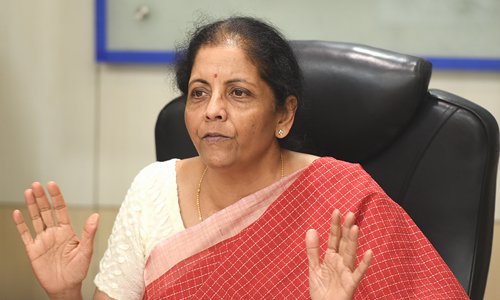SOURCE / INDUSTRIES
India eyes to lure global manufacturing giants from China

Indian Finance Minister Nirmala Sitharaman Photo: IC
India has reportedly decided to launch a plan to lure global manufacturing giants that now operate in China and may decide to leave because of the China-US trade war. Experts and other sources noted on Monday that weak infrastructure facilities and unsatisfying business environments in India would be major restraining factors that could deter the migration of the global manufacturing giants.
Indian Finance Minister Nirmala Sitharaman said that it might be important for the government to move "now and see and meet up with industries and invite them [to India]," the Hindustan Times reported.
Sitharaman said the focus could be on some specific sectors including electronics, lithium ion batteries and semi-conductors, according to the report.
Affected by market uncertainty caused by the trade war between China and the US, some foreign companies in China intend to move production lines away from China, an Indian source familiar with the matter, who wished to remain anonymous, told the Global Times on Monday.
These foreign businesses in China even have a "China+" plan to build another development base outside of China, hoping to avoid market risks. Vietnam and India are among these businesses' new destinations, according to the source.
However, it is difficult to say whether India could realize its aspiration of attracting investment, since it suffers from poor infrastructure construction, a less-skilled labor force and a relatively immature business environment compared with China, said the source.
Industrial relocation is a dynamic process regardless of whether there is a trade war or not, and what really decides firms' movements is the comprehensive assessment of their operating costs and future markets across the world. India does not have an absolute predominance over China, Zhang Jianping, director general with the Center for Regional Economic Cooperation under the Ministry of Commerce, told the Global Times on Monday.
It is true that some labor-concentrated industries in China have been shifting production to South or Southeast Asian regions, or deliberating such a shift, due to China's industrial upgrading and higher labor costs, Zhang said.
Even with its labor force being vast and low-cost, two of its biggest advantages, India's relatively weak infrastructure facilities would be a critical restraining factor. This would be particularly significant for high value-added industries such as smartphone producers, which need to be supported by an adequate air transport capacity, Zhang said.
In addition, India's unsatisfactory administrative efficiency is also a barrier for foreign investors around the world, and the country is still facing strong competition from Southeast Asian countries, which have relatively higher production efficiency and lower costs in undertaking production lines from China, Zhang noted.

